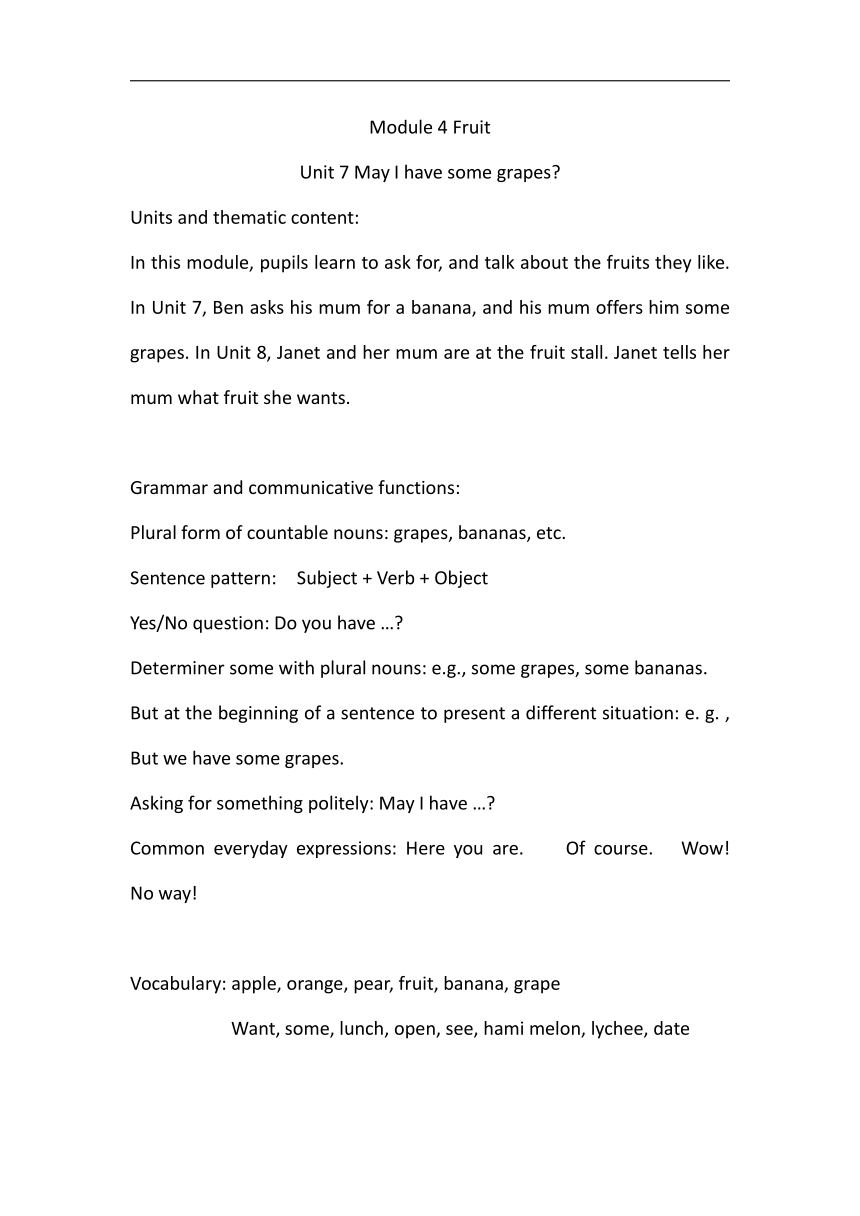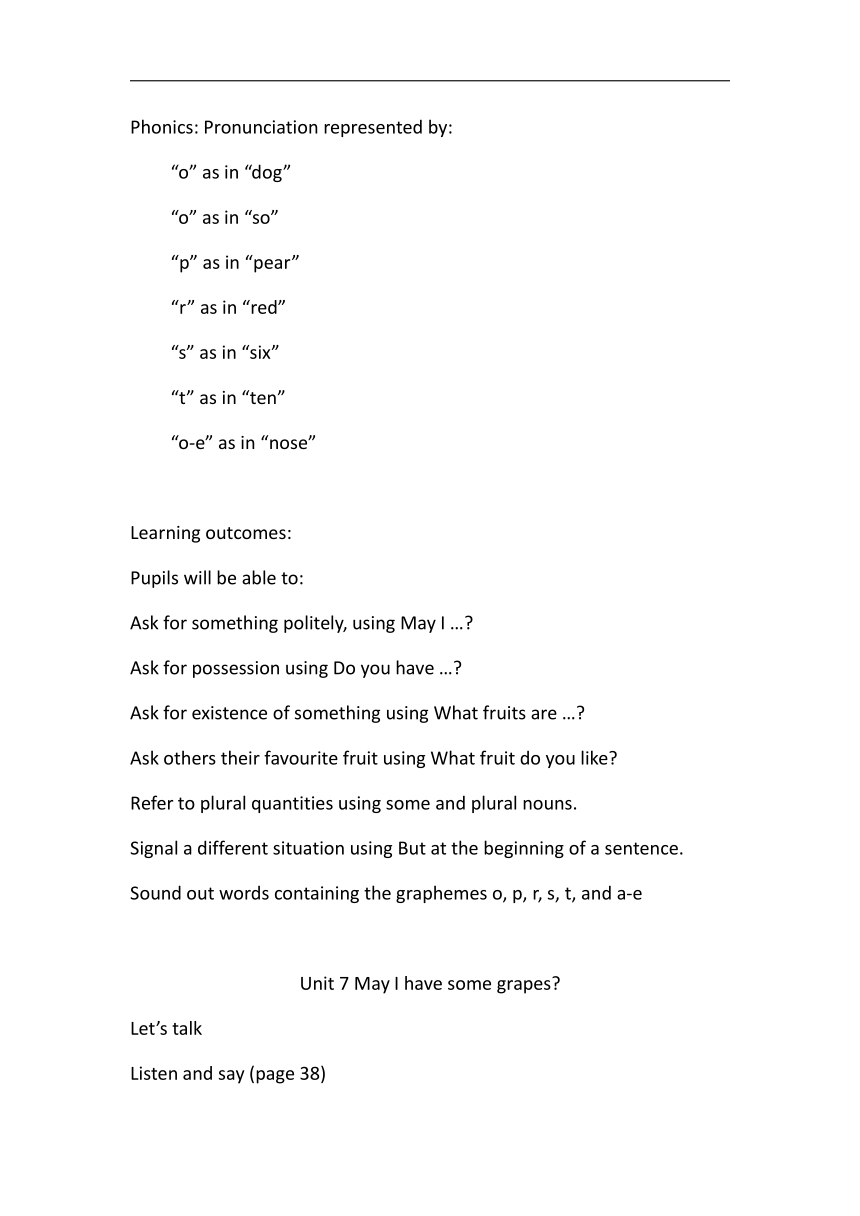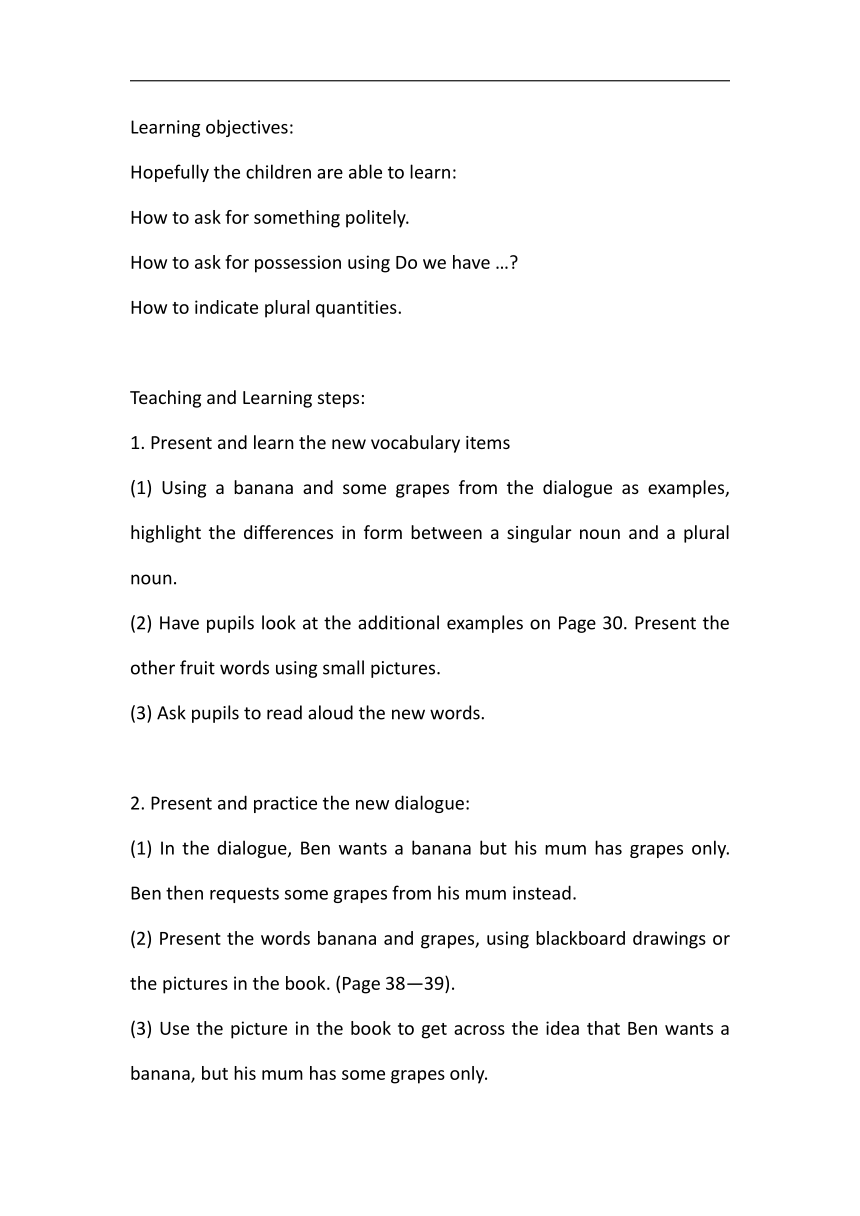Module 4 Fruits Unit 7 May I have some grapes 教案
文档属性
| 名称 | Module 4 Fruits Unit 7 May I have some grapes 教案 |

|
|
| 格式 | docx | ||
| 文件大小 | 17.9KB | ||
| 资源类型 | 教案 | ||
| 版本资源 | 教科版(广州) | ||
| 科目 | 英语 | ||
| 更新时间 | 2022-05-11 18:05:52 | ||
图片预览



文档简介
Module 4 Fruit
Unit 7 May I have some grapes
Units and thematic content:
In this module, pupils learn to ask for, and talk about the fruits they like. In Unit 7, Ben asks his mum for a banana, and his mum offers him some grapes. In Unit 8, Janet and her mum are at the fruit stall. Janet tells her mum what fruit she wants.
Grammar and communicative functions:
Plural form of countable nouns: grapes, bananas, etc.
Sentence pattern: Subject + Verb + Object
Yes/No question: Do you have …
Determiner some with plural nouns: e.g., some grapes, some bananas.
But at the beginning of a sentence to present a different situation: e. g. , But we have some grapes.
Asking for something politely: May I have …
Common everyday expressions: Here you are. Of course. Wow! No way!
Vocabulary: apple, orange, pear, fruit, banana, grape
Want, some, lunch, open, see, hami melon, lychee, date
Phonics: Pronunciation represented by:
“o” as in “dog”
“o” as in “so”
“p” as in “pear”
“r” as in “red”
“s” as in “six”
“t” as in “ten”
“o-e” as in “nose”
Learning outcomes:
Pupils will be able to:
Ask for something politely, using May I …
Ask for possession using Do you have …
Ask for existence of something using What fruits are …
Ask others their favourite fruit using What fruit do you like
Refer to plural quantities using some and plural nouns.
Signal a different situation using But at the beginning of a sentence.
Sound out words containing the graphemes o, p, r, s, t, and a-e
Unit 7 May I have some grapes
Let’s talk
Listen and say (page 38)
Learning objectives:
Hopefully the children are able to learn:
How to ask for something politely.
How to ask for possession using Do we have …
How to indicate plural quantities.
Teaching and Learning steps:
1. Present and learn the new vocabulary items
(1) Using a banana and some grapes from the dialogue as examples, highlight the differences in form between a singular noun and a plural noun.
(2) Have pupils look at the additional examples on Page 30. Present the other fruit words using small pictures.
(3) Ask pupils to read aloud the new words.
2. Present and practice the new dialogue:
(1) In the dialogue, Ben wants a banana but his mum has grapes only. Ben then requests some grapes from his mum instead.
(2) Present the words banana and grapes, using blackboard drawings or the pictures in the book. (Page 38—39).
(3) Use the picture in the book to get across the idea that Ben wants a banana, but his mum has some grapes only.
(4) Arouse interest by saying: Ben wants a banana. Let’s see what he will get in the end.
(5) Play the recording again, pausing after each sentence to guide or check understanding. Help pupils understand the meaning of:
Do we have bananas
May I have some grapes
But we have …
(6) Conduct reading aloud practice on the dialogue. Read the dialogue in various ways.
3. Development and consolidation:
(1) Call out a fruit item either in singular or plural form, and pupils will point out the correct picture in their books.
(2) Exchange some of the items in the dialogue and ask the children to ask and answer and make new dialogues like the text.
(3) Act out the dialogue in roles. Use the deaddresses.
(4) In pairs, pupils will re-do the dialogue, substituting a banana and some grapes with the fruit words from the 6 pictures on Page 39. Check that the new dialogues make sense.
教学反思:
同学们对于水果这个课题相当的感兴趣,还有他们对于课堂中创设的情境很感兴趣,我带了水果和围裙,让他们很快进入了角色,感觉到真情实感。还有,单数和复数孩子们本来就有一定的基础,这样学下来觉得比较轻松。至于词汇的拼写方面,Unit 7 的词汇比较多,我分开了三个课时进行教学,每次教一个新单词都要求集思广益,一起找找金点子和银点子,学生养成了发散思维的能力。
Unit 7 May I have some grapes
Fun With Language:
1. Listen and match (Page 40)
Learning and teaching objectives:
To listen to the correct fruit item according to the given colour.
In this activity, pupils will hear 4 mini dialogues. In each dialogue, one of the 4 hildren asks a parent or grandparent for some fruit.
Have pupils look at the pictures of the fruits in the book (Page 40, Part 1). Revise the names of the fruits and the colours.
Arouse interest by saying: Does Ben want an apple Which apple Does Ben want some bananas Which bananas
If necessary, play the first mini dialogue and try the first question with the pupils.
Play the recording, stopping after every mini dialogue for pupils to do the matching.
When pupils have finished, play the recording again for them to check their answers.
Assessment: When you have checked the answers with the pupils, ask them to tell you what fruit each child wants:
What does Janet want
Some green apples.
2. Play the game(Page 40)
(1) In this board game, pupils compete to be the first one to reach the finish square. Playing in pairs or in groups, each pupil tosses a die, and moves his/her marker on the game board accordingly. Then he/she has to be able to say Can I have … Correctly according to the square he/she lands on. If he/she makes a mistake, he/she will have to return to his/her original square.
(2) Revise the expression for requesting something (May I have… ) You may say: You want … How do you ask for … politely
(3) Tell pupils that Can I have … Is another polite way for asking for something. Provide pupils with some quick practice by PPT.
(4) Have pupils study the game board carefully and explain the task by P1. Invite two pupils to give demonstration in front of the class. 使用实物投影仪
(5) In groups , play the game.
教学反思:
在三(1)班我用了在两人小组中进行这个活动,因为他们是网络实验班,习惯了两两说的形式,而且操练的密度会更大,让学生上口的机会和运用知识的机会更多,但是在三(2)班我只能用小组的形式,因为像他们这样有个别学生的差距是比较大的,还有,个别学生比较自私,不会合作的。
Unit 7 May I have some grapes
Units and thematic content:
In this module, pupils learn to ask for, and talk about the fruits they like. In Unit 7, Ben asks his mum for a banana, and his mum offers him some grapes. In Unit 8, Janet and her mum are at the fruit stall. Janet tells her mum what fruit she wants.
Grammar and communicative functions:
Plural form of countable nouns: grapes, bananas, etc.
Sentence pattern: Subject + Verb + Object
Yes/No question: Do you have …
Determiner some with plural nouns: e.g., some grapes, some bananas.
But at the beginning of a sentence to present a different situation: e. g. , But we have some grapes.
Asking for something politely: May I have …
Common everyday expressions: Here you are. Of course. Wow! No way!
Vocabulary: apple, orange, pear, fruit, banana, grape
Want, some, lunch, open, see, hami melon, lychee, date
Phonics: Pronunciation represented by:
“o” as in “dog”
“o” as in “so”
“p” as in “pear”
“r” as in “red”
“s” as in “six”
“t” as in “ten”
“o-e” as in “nose”
Learning outcomes:
Pupils will be able to:
Ask for something politely, using May I …
Ask for possession using Do you have …
Ask for existence of something using What fruits are …
Ask others their favourite fruit using What fruit do you like
Refer to plural quantities using some and plural nouns.
Signal a different situation using But at the beginning of a sentence.
Sound out words containing the graphemes o, p, r, s, t, and a-e
Unit 7 May I have some grapes
Let’s talk
Listen and say (page 38)
Learning objectives:
Hopefully the children are able to learn:
How to ask for something politely.
How to ask for possession using Do we have …
How to indicate plural quantities.
Teaching and Learning steps:
1. Present and learn the new vocabulary items
(1) Using a banana and some grapes from the dialogue as examples, highlight the differences in form between a singular noun and a plural noun.
(2) Have pupils look at the additional examples on Page 30. Present the other fruit words using small pictures.
(3) Ask pupils to read aloud the new words.
2. Present and practice the new dialogue:
(1) In the dialogue, Ben wants a banana but his mum has grapes only. Ben then requests some grapes from his mum instead.
(2) Present the words banana and grapes, using blackboard drawings or the pictures in the book. (Page 38—39).
(3) Use the picture in the book to get across the idea that Ben wants a banana, but his mum has some grapes only.
(4) Arouse interest by saying: Ben wants a banana. Let’s see what he will get in the end.
(5) Play the recording again, pausing after each sentence to guide or check understanding. Help pupils understand the meaning of:
Do we have bananas
May I have some grapes
But we have …
(6) Conduct reading aloud practice on the dialogue. Read the dialogue in various ways.
3. Development and consolidation:
(1) Call out a fruit item either in singular or plural form, and pupils will point out the correct picture in their books.
(2) Exchange some of the items in the dialogue and ask the children to ask and answer and make new dialogues like the text.
(3) Act out the dialogue in roles. Use the deaddresses.
(4) In pairs, pupils will re-do the dialogue, substituting a banana and some grapes with the fruit words from the 6 pictures on Page 39. Check that the new dialogues make sense.
教学反思:
同学们对于水果这个课题相当的感兴趣,还有他们对于课堂中创设的情境很感兴趣,我带了水果和围裙,让他们很快进入了角色,感觉到真情实感。还有,单数和复数孩子们本来就有一定的基础,这样学下来觉得比较轻松。至于词汇的拼写方面,Unit 7 的词汇比较多,我分开了三个课时进行教学,每次教一个新单词都要求集思广益,一起找找金点子和银点子,学生养成了发散思维的能力。
Unit 7 May I have some grapes
Fun With Language:
1. Listen and match (Page 40)
Learning and teaching objectives:
To listen to the correct fruit item according to the given colour.
In this activity, pupils will hear 4 mini dialogues. In each dialogue, one of the 4 hildren asks a parent or grandparent for some fruit.
Have pupils look at the pictures of the fruits in the book (Page 40, Part 1). Revise the names of the fruits and the colours.
Arouse interest by saying: Does Ben want an apple Which apple Does Ben want some bananas Which bananas
If necessary, play the first mini dialogue and try the first question with the pupils.
Play the recording, stopping after every mini dialogue for pupils to do the matching.
When pupils have finished, play the recording again for them to check their answers.
Assessment: When you have checked the answers with the pupils, ask them to tell you what fruit each child wants:
What does Janet want
Some green apples.
2. Play the game(Page 40)
(1) In this board game, pupils compete to be the first one to reach the finish square. Playing in pairs or in groups, each pupil tosses a die, and moves his/her marker on the game board accordingly. Then he/she has to be able to say Can I have … Correctly according to the square he/she lands on. If he/she makes a mistake, he/she will have to return to his/her original square.
(2) Revise the expression for requesting something (May I have… ) You may say: You want … How do you ask for … politely
(3) Tell pupils that Can I have … Is another polite way for asking for something. Provide pupils with some quick practice by PPT.
(4) Have pupils study the game board carefully and explain the task by P1. Invite two pupils to give demonstration in front of the class. 使用实物投影仪
(5) In groups , play the game.
教学反思:
在三(1)班我用了在两人小组中进行这个活动,因为他们是网络实验班,习惯了两两说的形式,而且操练的密度会更大,让学生上口的机会和运用知识的机会更多,但是在三(2)班我只能用小组的形式,因为像他们这样有个别学生的差距是比较大的,还有,个别学生比较自私,不会合作的。
同课章节目录
- Module 1 Colours
- Unit 1 I like red
- Unit 2 Let's colour it
- Module 2 Positions
- Unit 3 Where's my car?
- Unit 4 Is it in your bag?
- Module 3 Personal information
- Unit 5 Happy birthday!
- Unit 6 May I have your telephone number?
- Module 4 Fruits
- Unit 7 May I have some grapes?
- Unit 8 Apple are good for us
- Module 5 Relatives
- Unit 9 Who is this cute baby?
- Unit 10 How many people are there in your family?
- Module 6 Pets
- Unit 11 They're lovely
- Unit 12 Whose rabbits are these?
- Module 7 Let's look back
